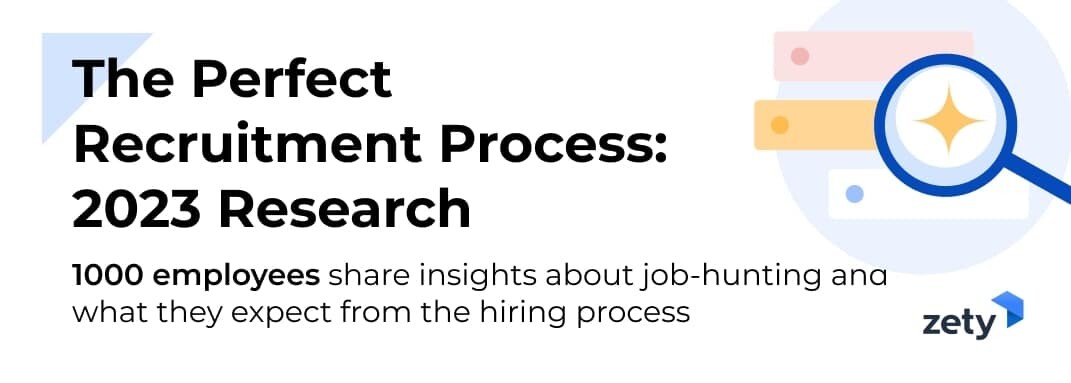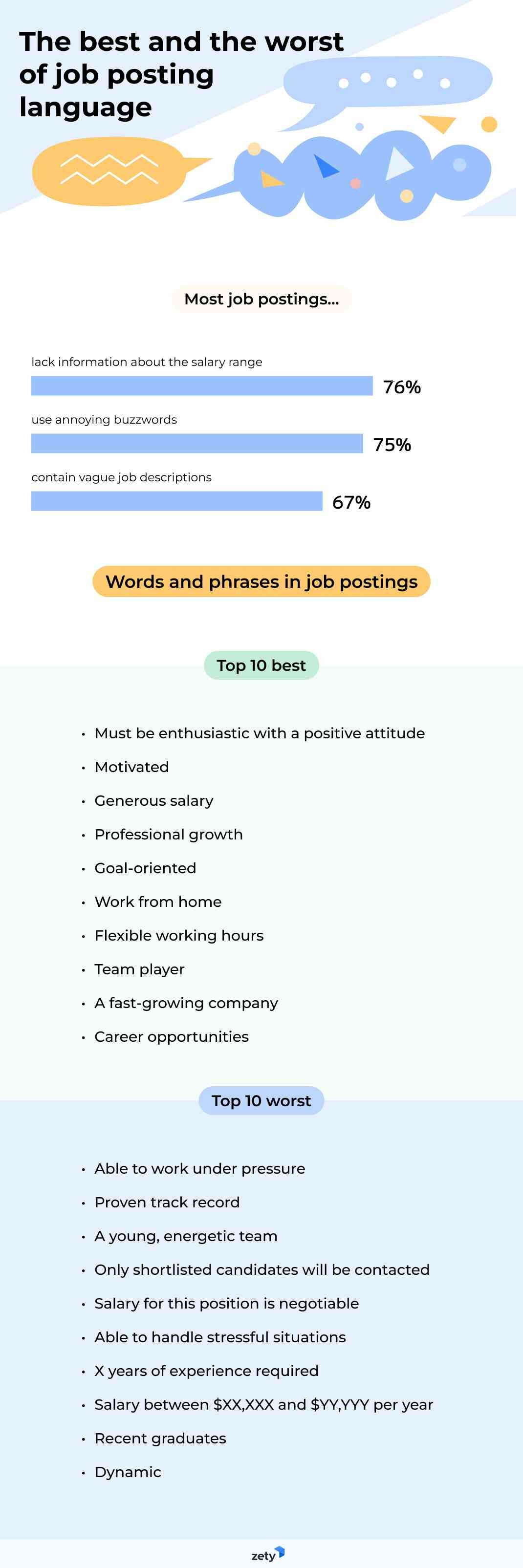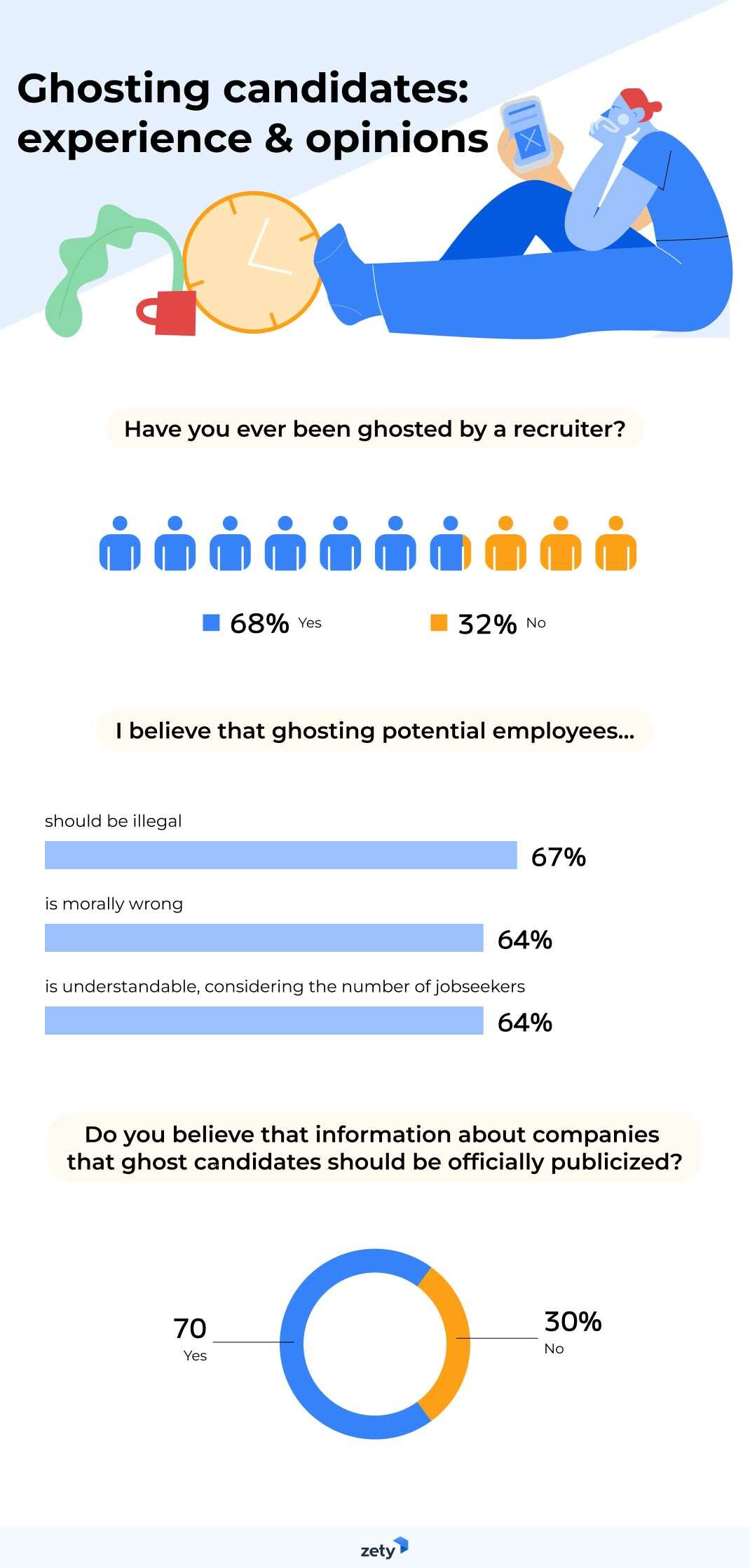
Recruitment is like a roller coaster ride. It gives you a thrill but can also make you sick.
Constantly scrolling job offers. Feeling up and down. Winning, losing, fighting.
Job postings are heavy on buzzwords. But light on specific information about the position.
High hopes dashed by a low salary. Or, more likely, nothing about salary at all.
Dozens of resumes sent. No job interview landed.
You’re a perfect cultural fit for the company. But with an imperfect skill set for the job.
Too old, too young, overqualified, underqualified… Everything at once.
Sound familiar? You’re not alone. The list of job-hunting pet peeves seems endless. Unrealistic expectations, vague job descriptions, and age-biased postings are just the tip of the iceberg.
Let’s have a look at some recent data on the recruitment process.
- An unpleasant hiring process can scare away qualified candidates. According to CareerPlug’s 2023 Candidate Experience Report, 49% of job seekers had declined a job offer due to a poor recruitment experience.
- The latest Jobvite's Employ Quarterly Insights Report revealed that having to endure multiple rounds of interviews is the most disliked part of the hiring process for 62% of candidates.
- Remote's global study on inclusive hiring practices uncovered that 49% of job hunters had faced discrimination in the hiring process.
Recruitment is accepted as a time-consuming and stressful process, requiring a great deal of patience. But does it have to be like that? Not necessarily. Smart companies are rethinking their recruitment strategies to attract top talents. But how about the others? Is their awareness growing? What does it mean to job seekers? Let’s find out.
At Zety, we surveyed 1000 employees to examine:
- Their first-hand experiences with job hunting
- Timing & feedback in a recruitment process
- Job application triggers and turn-offs
- Language of job postings
- Discrimination & bias during recruitment
- Opinions about job interviews
- Ghosting jobseekers
Key findings:
- 77% of respondents feel most job ads target people under 40.
- 69% believe they’ve been discriminated against during recruitment because of their appearance.
- 67% claim that ghosting potential employees by recruiters should be illegal
- 71% would be discouraged from applying for the job if its description was vague.
- 79% would be encouraged to apply for a job with flexible work arrangements.
- 75% think job postings use annoying buzzwords.
- “Able to work under pressure,” “Proven track record,” and “A young, energetic team” are the most hated job posting phrases.
But that’s not all. Keep reading to discover what else our study unveiled.
First-hand experience with job hunting

To begin with, we asked respondents a few questions about their experience with job seeking.
- 3.6 – that’s how, on average, research participants rated their overall experience with recruitment processes [on a scale of 1 to 5]. Could be better, could be worse.
- In the last 12 months, as many as 85% of respondents have applied for a job. The percentage was noticeably higher (92%) for ethnic minorities but lower (75%) for survey takers without college degrees.
Digging deeper, of those who had applied for a job, we also wanted to know how many applications they made in the last year. The answers were the following:
- Up to 10 – 20%
- 11–25 – 34%
- 26–40 – 29%
- 41–55 – 16%
- 55 or more – 1%
When it came to the number of job interviews they landed, these are the answers we got:
- Up to 5 – 17%
- 6–10 – 54%
- 11–19 – 27%
- 20 or more – 2%
Interestingly, participants working in the business and finance sector seemed the most active job seekers. In the last 12 months, 33% of them have applied for a job 41–55 times, and 42% have had 11–19 job interviews. Busy bees.
Let’s move on to such burning recruitment issues as timing and feedback.
Timing & feedback in a recruitment process
Are recruitment processes too long, too short, or timed perfectly? Opinions vary.
- 29% of respondents considered recruitment processes too short.
- 31% believed they took too long.
- 40% thought they were an ideal length.
Time to closely examine candidates’ experiences and perspectives on feedback.
- A full 81% of research participants said they hadn’t received any feedback during the recruitment process. The situation was even more common among ethnic minority respondents (88%). Lack of feedback was also more prevalent among education industry workers than among healthcare professionals (86% vs. 73%).
Is feedback a must in the perfect hiring process, then? According to the vast majority of our respondents, it definitely is.
- 82% of participants believed candidates should get confirmation that their application has been delivered.
Still, there were some disparities in answers given by survey takers from different demographic groups. People with greater work experience and those employed at bigger companies would most likely expect confirmation of their application delivery.
- Years of work experience: 1–2 years—69% vs. 11+ years or more—91%.
- Company size: 1–10 employees—73% vs. 501+ employees—92%.
Another noteworthy study finding to mention here:
- 76% of respondents claimed candidates should get feedback after every recruitment stage.
We also asked how long it should take from the time you send your resume to the first contact from the company. The answers were the following:
- Up to 3 days – 10%
- 4–7 days – 41%
- 8–13 days – 35%
- 14–20 days – 12%
- Three weeks or more – 2%
When it comes to time from the last stage of the recruitment process to receiving a final decision, participants claimed it should take:
- Up to 3 days – 10%
- 4–7 days – 37%
- 8–13 days – 34%
- 14–20 days – 15%
- Three weeks or more – 4%
Let’s sum up. Recruiters shouldn’t keep potential employees in suspense for more than a week. This applies both to the first and the final contact from the company.
Interestingly, participants without college degrees seemed the most patient group of survey takers. 16% wouldn’t have a problem with waiting for three weeks or more for their first contact from the employer. 17% could wait the same amount of time for the final decision.
We finished this section by asking about the number of stages that a perfect recruitment process has. The answers were the following:
- 1 – 2%
- 2 – 21%
- 3 – 45%
- 4 – 28%
- 5 or more – 4%
Less is often more. An overly complex, multistaged recruitment process may be discouraging for many valuable candidates.
Applying for jobs can be a complicated process, but if you pay little attention to it, you can discourage talented people from applying for a position. Just like in marketing, in which the goal is to create the quickest route from first engagement to conversion, the same care should be taken in getting a candidate to apply.
Designing an application process that is simple to understand, easy to fill out, and asks for just the information needed for initial screening needs, is the best way to avoid a candidate becoming discouraged or exasperated with the number of steps needed just to get their preliminary information in. By spending as much time simplifying your application process, you will avoid losing candidates to an overbearing list of tasks and is one of the best practices to improve recruitment efforts.
Let’s move on to the thing that makes us apply in the first place. Job postings.
Job application triggers and turn-offs

What attracts applicants, and what puts them off in job postings? Let’s find out. We asked our respondents to choose up to three options to complete the sentence: “I would be discouraged from applying for a job if…”
- the job ad showed insufficient pay compared to similar roles – 71%
[ethnic minorities—82%, education industry workers—81%, master degree holders—80%]
- the job description was vague – 71%
[master degree holders—85%]
- the job ad showed hourly pay instead of a salary – 67%
- the job ad showed insufficient time off – 67%
[ethnic minorities—78%; healthcare—46%]
- the job ad showed no health insurance – 67%
[ethnic minorities—82%, healthcare—55%)
- the job ad showed no dental insurance – 66%
- the benefits weren’t listed in the job ad – 65%
[software/IT—70% vs. healthcare—44%; ethnic minorities—75%]
- the job ad showed insufficient sick leave – 65%
[blue collar workers—75%]
- the job ad showed no retirement plans – 64%
- the pay wasn’t listed in the job ad – 63%
[blue-collar workers—80% vs. white-collar workers—59%; healthcare—50%]
As you can see, applicants don’t want to waste their time applying for a job when what the job is and what it involves seems vague. They also need to be paid fairly compared to similar roles. And unclear job descriptions and insufficient pay can discourage even the most determined job seekers from applying for the given position.
Let’s change the perspective now. We also examined what could attract candidates to apply for the job. The procedure was the same. Participants checked up to three options to complete the sentence: “I would be encouraged to apply for a job if…”
- the job description was interesting – 81%
[company hiring more than 501 employees—91%]
- the work duties corresponded with my interests – 80%
[company hiring more than 501 employees—90%]
- the job ad showed opportunities for growth – 79%
- the job ad showed flexible work arrangements – 79%
[Bachelor's degree holders—81% vs. no college degree holders—69%]
- the job ad showed retirement plans – 78%
- the job ad showed attractive benefits – 76%
[education—81% vs. healthcare—58%]
- the job ad showed health insurance – 75%
[business & finance—82% vs. education—68%]
- the job ad showed a high salary compared to similar roles – 74%
Respondents considered engaging job descriptions, work duties corresponding with their interests, growth opportunities, and flexible work arrangements more important than a high salary. Money is not everything. Employers, take note.
What’s the recipe for a good job posting, then?
Good job postings strike an effective balance between laying out the requirements and qualifications for the job and also selling the position by mentioning the perks. Including the compensation range is a key first step here, but talking about your company's culture and the kind of work they would be doing in a qualitative sense also matters a lot to thoughtful job applicants.
Language of job postings

We also investigated the language of job postings.
- 76% of participants claimed most job postings lack information about the salary range. This omission seemed more noticeable for respondents with greater job experience (11 years or more) than for those taking the first steps on their career path (1–2 years)—84% vs. 66%.
- 75% of survey takers believed job postings used annoying buzzwords. Ethnic minorities (87%) and master’s degree holders (86%) were particularly sensitive to that language issue.
- According to 67% of respondents, most job postings contained vague job descriptions.
Digging deeper, we examined which are the most liked and most disliked words and phrases used in job postings.
The top 10 best were:
- Must be enthusiastic with a positive attitude
- Motivated
- Generous salary
- Professional growth
- Goal-oriented
- Work from home
- Flexible working hours
- Team player
- A fast-growing company
- Career opportunities
Conversely, the top 10 worst were:
- Able to work under pressure
- Proven track record
- A young, energetic team
- Only shortlisted candidates will be contacted
- Salary for this position is negotiable
- Able to handle stressful situations
- X years of experience required
- Salary between $XX,XXX and $YY,YYY per year
- Recent graduates
- Dynamic
Notably, the highest-rated phrases are associated with good energy, growth, and flexibility. On the other hand, those ranked as the worst are exclusive/discriminatory (“recent graduates,” “a young, energetic team”), related to potential failure (“only shortlisted candidates will be contacted”), and negative workplace atmosphere (“under pressure,” “stressful situations”), or too vague (“negotiable salary”).
Discrimination & bias during recruitment

Other crucial areas to investigate while reflecting on perfect recruitment are discrimination and bias in the hiring process. What’s the scale of the problem? And what can employers do to prevent it from happening? Let’s see.
We asked research participants if they’d ever been discriminated against during recruitment. The answers touched a raw nerve.
- 78% believed they’d been discriminated against because of their age.
- 69% because of their appearance [business & finance—78% vs. healthcare—57%].
- 67% because of their race.
- 65% because of their gender.
Other worthwhile study findings to note:
- 74% of respondents agreed that bias-free job postings attract a broader range of talents.
- 62% (68% male vs. 56% female) claimed they had seen job ads using sexist language. Additionally, 72% were of the opinion that gendered-biased job postings should be illegal.
- 64% had seen job ads using ageist language. Also, according to 68%, age-biased should be illegal.
- 77% felt that job postings were addressed to people younger than 40.
- On a positive note, most research participants considered job postings as addressed equally to women and men.
So recruitment discrimination does exist, but candidates are very aware of it, and the majority want to see it eradicated.
But how can this be achieved? What are some best inclusive hiring practices?
In my experience, the best way to ensure job postings are gender/age bias-free is to keep your eyes open for language that might be unintentionally biased. For example, if I'm writing a job description and I use the phrase "must play well with others," it's easy for me to assume that this is a requirement for every role at every company. But it's not! Not all companies require their employees to work well together.
So instead of using the phrase “must play well with others,” I would just say something like: “This position requires you to work with other employees.” That leaves room for someone who is an amazing individual contributor but doesn't excel at collaboration or teamwork. It also leaves room for someone who thrives in a collaborative environment but isn't good at working independently—both of which are equally valid skill sets!
Use gender and age-neutral language in all of your job postings. For instance, Instead of using “he” or “she,” use “they” or “the successful candidate.” Additionally, avoid using gendered job titles, such as “salesman” or “waitress,” and instead use gender-neutral titles like “sales representative” or “server.” When it comes to age, avoid using age qualifiers such as “young,” “energetic,” “mature and experienced,” or “recent graduate”. The best practice is to focus on the job-related qualifications, including the skills, experience, and education necessary for the job. It’s also critical that the individuals responsible for creating and reviewing job postings represent a diverse range of backgrounds and experiences. This can help to identify and eliminate any biases that may be present in the posting. You could also use an online tool, such as Textio or Gender Decoder, that analyzes your job posting for gender and age bias and suggests alternative language.
Let these experts’ opinions be food for thought for any employers, hiring managers, and recruiters here. Time to move on to job interviews.
Job interviews: opinions & expectations

Next, we moved on to job interviews. We investigated participants’ experiences, attitudes, and expectations.
- 73% of respondents would assess their overall experience with job interviews as positive/very positive.
- 19% remained neutral.
- Only 8% considered it negative/very negative.
Interestingly, there were noticeable differences in answers among various demographic groups. Some respondents seemed way happier about their experience with job interviews than others. [% of positive/very positive answers]:
- Age: 41 or older—76% vs. 25 or younger—63%
- Years of work experience: 11 years or more—84% vs. 1–2 years—57%
- Industry: healthcare—81% vs. education—60%
- Company size: 201–500 employees—81% vs. 1–10 employees—57%
When asked about the preferable format for of job interview, survey takers answered as follows:
- Face-to-face job interviews – 40%
[education—49% vs. software/IT—38%; no college degree 27%]
- It depends on the recruitment stage. – 22%
- Online job interviews – 20%
- It makes no difference to me whether the job interview is online or face-to-face. – 18%
Participants also shared what was most important to them during an interview.
- Clear information about pay – 61%
[over 41y/o—65% vs. under 25 y/o—49%; education—70% vs. software/IT—55%]
- Friendly atmosphere – 50%
[26-40 y/o—58% vs. over 41 y/o—48%]
- Clear information about work duties – 47%
[healthcare—54% vs. education—40%]
- Information about benefits – 38%
[under 25 y/o—47% vs. 26–40 y/o—33%]
- Answering relevant questions – 32%
[healthcare—43% vs. education—28%]
- Chance to ask questions – 23%
- Doing a practical task – 8%
Once again, clear information about pay proved crucial in the recruitment process. No surprise. After all, money doesn’t grow on trees. And it is usually one of the key motivators to work.
The final question was, “What’s the maximum number of questions that should be asked during a job interview?”. Survey takers answered as follows:
- 1–5 – 8%
- 6–10 – 62%
- 11–20 – 28%
- 21 or more – 2%
Not too few, not too many. Striking a balance usually seems the best option.
What job interview practices contribute to the perfect recruitment process?
Interviews are a two-way street. Recruiters are tasked with assessing candidates' experience, industry knowledge, and how they will demonstrate alignment with the company. Therefore, candidates should assess the company and role to ensure both align with their interests and career objectives. This goes back to the importance of companies posting informative job descriptions and the impact it has on attracting top talent. Candidates will know what the company is looking for to solve and how their experience will execute the business needs. It is important to bring your authentic self to all conversations, become comfortable speaking about your accomplishments, and know your value. As your interview comes to a close, be prepared to ask the recruiter a few questions. Candidates’ questions should be strategic, relevant, and intentional.
Ghosting jobseekers

Let’s focus on recruiters ghosting potential employees now.
Almost 7 in 10 (68%) survey takers declared they had been ghosted by a recruiter. Two demographic groups that were particularly affected were ethnic minority participants (84%) and master’s degree holders (82%).
We also collected opinions about ghosting jobseekers.
- 67% of respondents believed that ghosting potential employees should be illegal.
- 64% considered it morally wrong.
- At the same time, 64% claimed it was understandable, considering the number of job seekers. But only 46% of healthcare workers shared this view.
- 70% were of the opinion that information about companies ghosting candidates should be officially publicized.
Ghosting job applicants is a serious problem. What are the reasons for that? Is there anything to stop it? Let's see what experts have to say.
Ghosting is, unfortunately, becoming more common because many recruiters are overloaded. Ghosting is likely to take place for two reasons, the recruiter simply does not have or take the time, or the recruiter is not confident in how to decline candidates in a positive way. The recruiter bandwidth issue could be overcome by utilizing an ATS that will automatically decline all interviewees once a candidate has been hired. For the difficult conversations piece, recruiters should role play and practice with a mentor or leader to gain confidence in how to decline a candidate and still keep them in their network for future opportunities. A decline for a job should not equal a burned bridge, but recruiters need to be trained on how to do that effectively.
Employee ghosting by recruiters is totally unacceptable. One reason may be that recruiters are so busy that they get overextended and get sloppy and simply do not have the time to follow up. Companies need to make sure that they have policies and practices in place to stop ghosting and require to follow up, and make sure they staff the recruiting function at a reasonable level. Perhaps ghosted candidates can post reviews of boards like Glassdoor so that organizations that ghost frequently will be called out so that people will avoid applying with them.
The recruitment process can be a battlefield. Still, the greater the effort, the greater the glory.
The good news is that more and more companies are adopting the employee-centered approach to hiring. As a result, they keep improving their talent acquisition techniques, use tools to remove bias, and, therefore, broaden their candidate pool.
Methodology
The findings presented were obtained by surveying 979 respondents online via a bespoke polling tool. They were asked questions about job hunting and the recruitment process. These included yes/no questions, scale-based questions relating to levels of agreement with a statement, questions that permitted the selection of multiple options from a list of potential answers, and a question that permitted open responses. All respondents included in the study passed an attention-check question.
Limitations
The data we are presenting relies on self-reports from respondents. Everyone who took our survey read and responded to each question without any research administration or interference. We acknowledge there are many potential issues with self-reported data, like selective memory, telescoping, attribution, or exaggeration.
Sources
- Dudharejia, M., “4 Reasons Why Candidates Have A Terrible Hiring Experience”
- Marks, G., “Employers Are Now ‘Ghosting’ Applicants In Tight Labor Market – And That’s Not All Bad”
- Maurer, R., “Recruiting 101: 5 Tips for Better Interviews”
- MIT Human Resources, “Ensuring Bias-Free Job Postings”
- Jobvite, Employ Quarterly Insights Report Q1 2023
- Palmeri, S., 2023 Candidate Experience Report
- Sunil, P., “10 Recruitment Trends To Keep An Eye On In 2023”
- Terrell, K., “Age Bias That's Barred by Law Appears in Thousands of Job Listings”
- Vatalidis, N., “Global Study: Inclusive Hiring Practices To Start Today”
- Volz, A., “The Language of Job Ad”
Fair use statement
Want to share the findings of our research? Go ahead. Feel free to use our images and information wherever you wish. Just link back to this page, please—it will let other readers get deeper into the topic. Additionally, remember to use this content exclusively for non-commercial purposes.
About Zety’s Editorial Process
This article has been reviewed by our editorial team to make sure it follows Zety's editorial guidelines. We’re committed to sharing our expertise and giving you trustworthy career advice tailored to your needs. High-quality content is what brings over 40 million readers to our site every year. But we don't stop there. Our team conducts original research to understand the job market better, and we pride ourselves on being quoted by top universities and prime media outlets from around the world.

